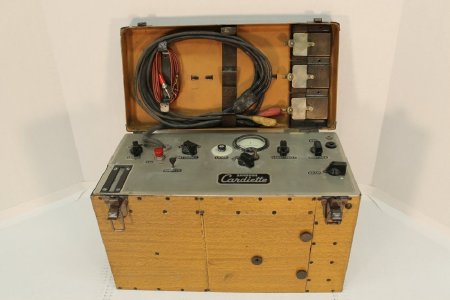Object ID Number:
2017.000.070
Object Name:
Electrocardiograph Machine
Type:
EKG Machine
Manufacturer:
Sanborn Company – Cambridge, MA
Date of Manufacture:
1925/ /
Description / History:
This Sanborn Cardiette Electrocardiograph is in a metal box with a wood design and has a leather handle. There are black plastic knobs on the inside, rubber tubing, and several leads. A hinged door on the front allows access to the tape along with another hinged door on the side to remove the readings. A version of this machine is in the Collection of Historical Scientific Instruments at Harvard University, which dates this model to around 1925.
Dimensions:
H–9 W–7 L–14 inches
Additional Information:
Electrocardiograms (EKGs)
An electrocardiogram (also called ECG or EKG) is a noninvasive test that records the electrical activity of the heart. This examination is useful because, with each heartbeat, an electrical signal spreads from the top to the bottom of the heart. As this electrical signal travels, it induces the heart to contract, and to pump blood throughout the body. Since the heart's electrical signals determine the rhythm of the heartbeat, an EKG can be used to show how quickly the heart is beating, whether the heart's rhythm is steady or irregular, and how strongly the electrical signals pass through each part of the heart. Based on these readings, a physician may discover a number of conditions, such as arrhythmias or recent heart attacks, and may also monitor the functioning of implanted pacemakers.
The earliest electrocardiogram was designed in 1901 by William Einthoven, a scientist from the Netherlands. In Einthoven's design, currents from the heart's electrical signals were carried down a silver coated glass conducting wire which was suspended between two electromagnets. The fluctuations of the wire as a result of the changing electrical currents were transcribed onto a photographic plate and produced readouts similar to those given by modern EKGs (although Einthoven's machine weighed 600 pounds, took up two rooms, and needed five people to operate).
EKGs remain one of the most important diagnostic tools today, and in 2011, 82,707 EKGs were performed at Lancaster General Hospital (or affiliated healthcare institutions), which amounts to a staggering 226 per day.
An electrocardiogram (also called ECG or EKG) is a noninvasive test that records the electrical activity of the heart. This examination is useful because, with each heartbeat, an electrical signal spreads from the top to the bottom of the heart. As this electrical signal travels, it induces the heart to contract, and to pump blood throughout the body. Since the heart's electrical signals determine the rhythm of the heartbeat, an EKG can be used to show how quickly the heart is beating, whether the heart's rhythm is steady or irregular, and how strongly the electrical signals pass through each part of the heart. Based on these readings, a physician may discover a number of conditions, such as arrhythmias or recent heart attacks, and may also monitor the functioning of implanted pacemakers.
The earliest electrocardiogram was designed in 1901 by William Einthoven, a scientist from the Netherlands. In Einthoven's design, currents from the heart's electrical signals were carried down a silver coated glass conducting wire which was suspended between two electromagnets. The fluctuations of the wire as a result of the changing electrical currents were transcribed onto a photographic plate and produced readouts similar to those given by modern EKGs (although Einthoven's machine weighed 600 pounds, took up two rooms, and needed five people to operate).
EKGs remain one of the most important diagnostic tools today, and in 2011, 82,707 EKGs were performed at Lancaster General Hospital (or affiliated healthcare institutions), which amounts to a staggering 226 per day.
